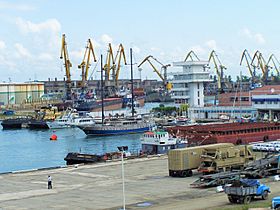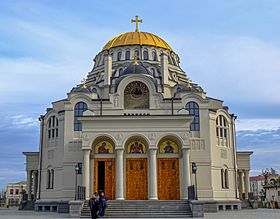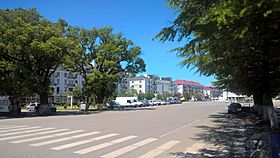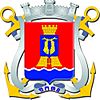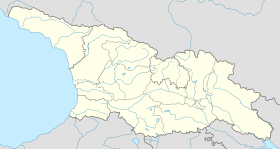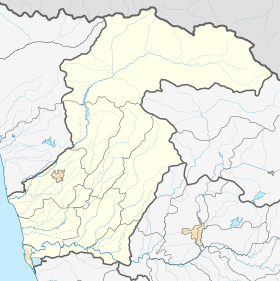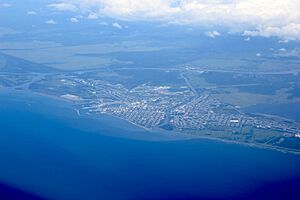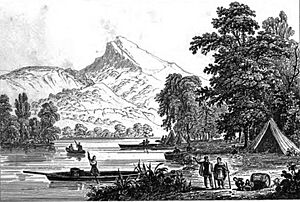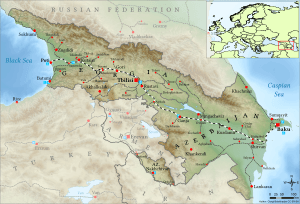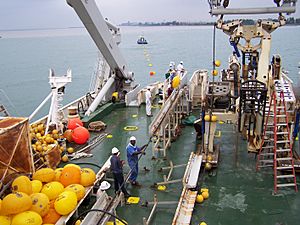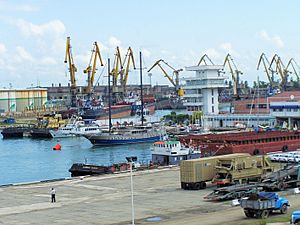Poti facts for kids
Quick facts for kids
Poti
ფოთი
|
|||
|---|---|---|---|
|
Above: Poti Sea Port, Middle: Poti Cathedral, Bottom: King Parnavaz Avenue
|
|||
|
|||
| Country | |||
| Mkhare | Samegrelo-Zemo Svaneti | ||
| Established | 7th century BC | ||
| Government | |||
| • Type | Mayor–Council | ||
| • Body | Poti City Assembly | ||
| Area | |||
| • Total | 65.8 km2 (25.4 sq mi) | ||
| Elevation | 0 m (0 ft) | ||
| Population
(January 1, 2024)
|
|||
| • Total | 41,170 | ||
| • Density | 625.7/km2 (1,620.5/sq mi) | ||
| Time zone | UTC+4 (Georgian Time) | ||
| Postal code |
4400-4499
|
||
Poti (Georgian: ფოთი) is a busy port city in Georgia. It is on the eastern coast of the Black Sea. Poti is in the Samegrelo-Zemo Svaneti region, in the west of the country. The city was built near an old Greek settlement called Phasis. Poti gets its name from this ancient place. Since the early 1900s, Poti has become a very important port and industrial area. It is also home to a main naval base for the Georgian Navy.
Contents
What's in a Name?
The name Poti is connected to the ancient name Phasis. But where the name "Phasis" came from is a bit of a mystery! Some experts think it came from a local river name. Others believe it might be linked to old Georgian words. Some even suggest it comes from a very old word meaning "a gold river."
Poti's Long History
Poti and the area around it have a history that goes back more than 2,600 years. In ancient times, there was a Greek city called Phasis here. Greek settlers from Miletus built it around 600 BC. This is the place where the famous Greek hero Jason and his Argonauts might have entered Georgia. They were on their quest to find the Golden Fleece.
For a long time, no one was sure exactly where this ancient city was. But thanks to underwater archaeology, we now have a better idea! It seems that a lake might have covered parts of the old city. Phasis was a key trading and cultural hub in the region called Colchis. It was an important stop on a trade route that went from India to the Black Sea.
Later, the Romans took control of Phasis. It also became a center for early Christianity. During a war between the Eastern Roman and Iranian empires, Iranian soldiers tried to attack Phasis but failed.
In the 700s, the name Poti started appearing in Georgian writings. It remained a trading port for the Kingdom of Georgia. European travelers knew it as Fasso. In the 1300s, people from Genoa (in Italy) set up a trading post here, but it didn't last long.
Modern Poti Begins
In 1578, the Ottoman Empire took over Poti. They called it Faş and built strong defenses. It also became a place where enslaved people were sold. Georgian armies tried to take Poti back but didn't succeed for a long time.
In 1828, Russia finally captured Poti. The town became an important port in 1858. The seaport was rebuilt between 1863 and 1905. In 1872, Poti became the end point of the Transcaucasus Railway. This railway connected Poti directly to Tiflis (now Tbilisi).
Poti grew a lot when Niko Nikoladze was mayor from 1894 to 1912. He is seen as the founder of modern Poti. Nikoladze oversaw many new projects. These included a theater, a large cathedral, schools, a power station, and an oil refinery. By 1900, Poti was one of the biggest ports on the Black Sea. It exported much of Georgia's manganese and coal.
During a brief time of independence (1918–1921), Poti was Georgia’s main link to Europe. It was also where German and British forces entered the country. In 1921, Soviet Russia took over Poti and Georgia. During the Soviet era, Poti continued to be a major seaport. It also became more industrialized and important for the military.
In 2008, during a conflict with Russia, Russian planes attacked the port. Even after a ceasefire, Russian troops stayed near the city for about a month before leaving.
Where Poti Is and Its Weather
Poti is about 312 kilometers (194 miles) west of Georgia’s capital, Tbilisi. It sits in a marshy area where the Rioni River flows into the Black Sea. The city is very close to sea level. Some areas that used to be marshes are now citrus fruit farms. The city is surrounded by the Kolkheti National Park. To the south, there's a small river called Kaparchina and Lake Paliastomi. About 5 kilometers (3 miles) south is Maltaqva, a local beach resort.
Poti has a humid subtropical climate. This means it has cool winters and hot summers. It gets a lot of rain, especially in the summer and fall. Snow is rare, only happening a few days a year. The hottest temperature ever recorded was 45.2°C (113.4°F) in July 2000.
| Climate data for Poti (1991–2020, extremes 1981-2020) | |||||||||||||
|---|---|---|---|---|---|---|---|---|---|---|---|---|---|
| Month | Jan | Feb | Mar | Apr | May | Jun | Jul | Aug | Sep | Oct | Nov | Dec | Year |
| Record high °C (°F) | 21.4 (70.5) |
25.0 (77.0) |
28.7 (83.7) |
34.4 (93.9) |
39.9 (103.8) |
36.5 (97.7) |
45.2 (113.4) |
38.0 (100.4) |
38.3 (100.9) |
33.6 (92.5) |
27.3 (81.1) |
24.5 (76.1) |
45.2 (113.4) |
| Mean daily maximum °C (°F) | 10.8 (51.4) |
11.9 (53.4) |
14.7 (58.5) |
19.1 (66.4) |
22.5 (72.5) |
26.3 (79.3) |
28.5 (83.3) |
29.1 (84.4) |
26.3 (79.3) |
22.3 (72.1) |
16.8 (62.2) |
12.8 (55.0) |
20.1 (68.2) |
| Mean daily minimum °C (°F) | 3.9 (39.0) |
4.0 (39.2) |
6.2 (43.2) |
9.1 (48.4) |
13.6 (56.5) |
18.0 (64.4) |
20.8 (69.4) |
21.1 (70.0) |
17.2 (63.0) |
13.2 (55.8) |
8.2 (46.8) |
5.4 (41.7) |
11.7 (53.1) |
| Record low °C (°F) | −6.2 (20.8) |
−10.0 (14.0) |
−6.8 (19.8) |
−1.0 (30.2) |
3.5 (38.3) |
9.0 (48.2) |
13.4 (56.1) |
12.2 (54.0) |
7.5 (45.5) |
0.0 (32.0) |
−1.3 (29.7) |
−4.7 (23.5) |
−10.0 (14.0) |
| Average precipitation mm (inches) | 154.6 (6.09) |
122.1 (4.81) |
128.2 (5.05) |
84.9 (3.34) |
95.1 (3.74) |
161.5 (6.36) |
227.3 (8.95) |
256.7 (10.11) |
270.2 (10.64) |
232.1 (9.14) |
173.5 (6.83) |
162.1 (6.38) |
2,068.3 (81.44) |
| Average precipitation days (≥ 1.0 mm) | 14 | 12 | 12.8 | 9.4 | 8.6 | 8.6 | 10 | 10.5 | 10.7 | 11 | 11 | 13.4 | 132 |
| Source: NCEI | |||||||||||||
Poti's Economy
The main parts of Poti's economy are services and food. The Poti Sea Port is very active. It can handle 7.7 million tons of goods each year. The railway that goes to Tbilisi makes Poti a more useful port than the natural harbor in Batumi.
In 2008, Georgia sold a part of the Poti port to a company from the UAE. This company plans to create a special "free industrial zone" (FIZ) in Poti. This zone will help new businesses grow. The President of Georgia officially opened this new zone in April 2008. There are also plans for a ferry route between Kerch and Poti.
Sports in Poti
The city's main football team is Kolkheti 1913 Poti. They play their games at the Fazisi Stadium.
Fiber Optic Network
In July 2008, a long submarine communications cable was laid. It stretches from Varna, Bulgaria across the Black Sea to Poti. This cable system is Georgia's first privately owned fiber-optic system. It helps people in Georgia get faster and cheaper internet, TV, and phone services.
Military Importance
Poti has been an important naval base for a long time. The Soviet government set up a naval base here in 1941 during World War II. It was part of the Black Sea Fleet. After the Soviet Union broke up, Russia removed its ships from Poti. However, Georgia then started building its own navy.
Today, Poti is a military facility for several Georgian military units. It is the main base for the Georgian navy. It also provides support for naval operations. There are also barracks for a special light infantry battalion of the Georgian Armed Forces.
Poti's International Friends
Poti has "twin towns" or "sister cities" around the world. These are cities that have special friendly relationships with Poti.
Twin Towns and Sister Cities
 Berdyansk, Ukraine
Berdyansk, Ukraine Chornomorsk, Ukraine
Chornomorsk, Ukraine Kiryat Yam, Israel
Kiryat Yam, Israel LaGrange, United States
LaGrange, United States Larnaca, Cyprus
Larnaca, Cyprus Nafplio, Greece
Nafplio, Greece Östhammar, Sweden
Östhammar, Sweden Pazar, Turkey
Pazar, Turkey /
/ Sevastopol, Ukraine/Russia
Sevastopol, Ukraine/Russia Shanwei, China
Shanwei, China Yazd, Iran (1990)
Yazd, Iran (1990)
See also
 In Spanish: Poti para niños
In Spanish: Poti para niños


